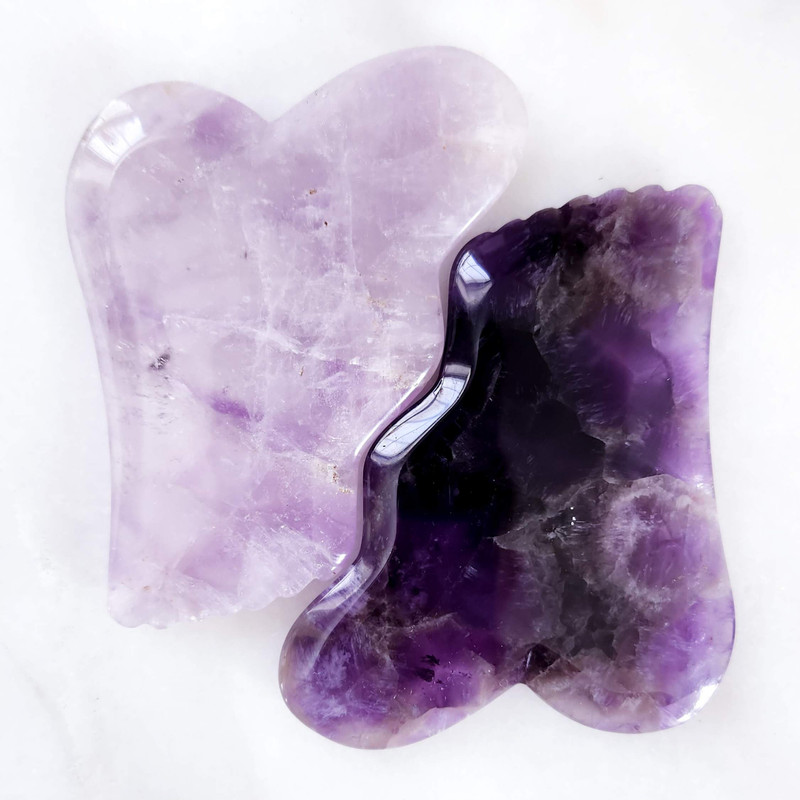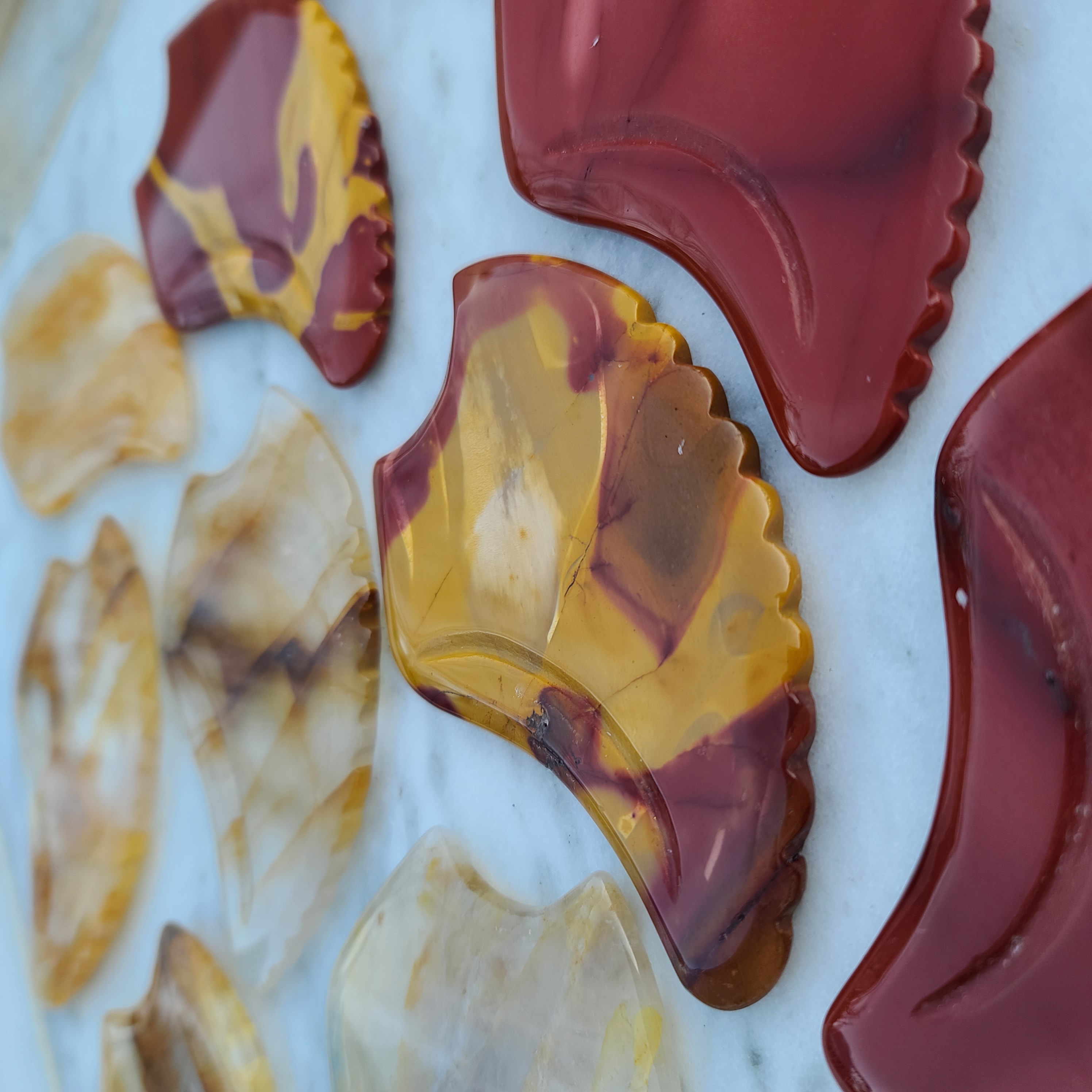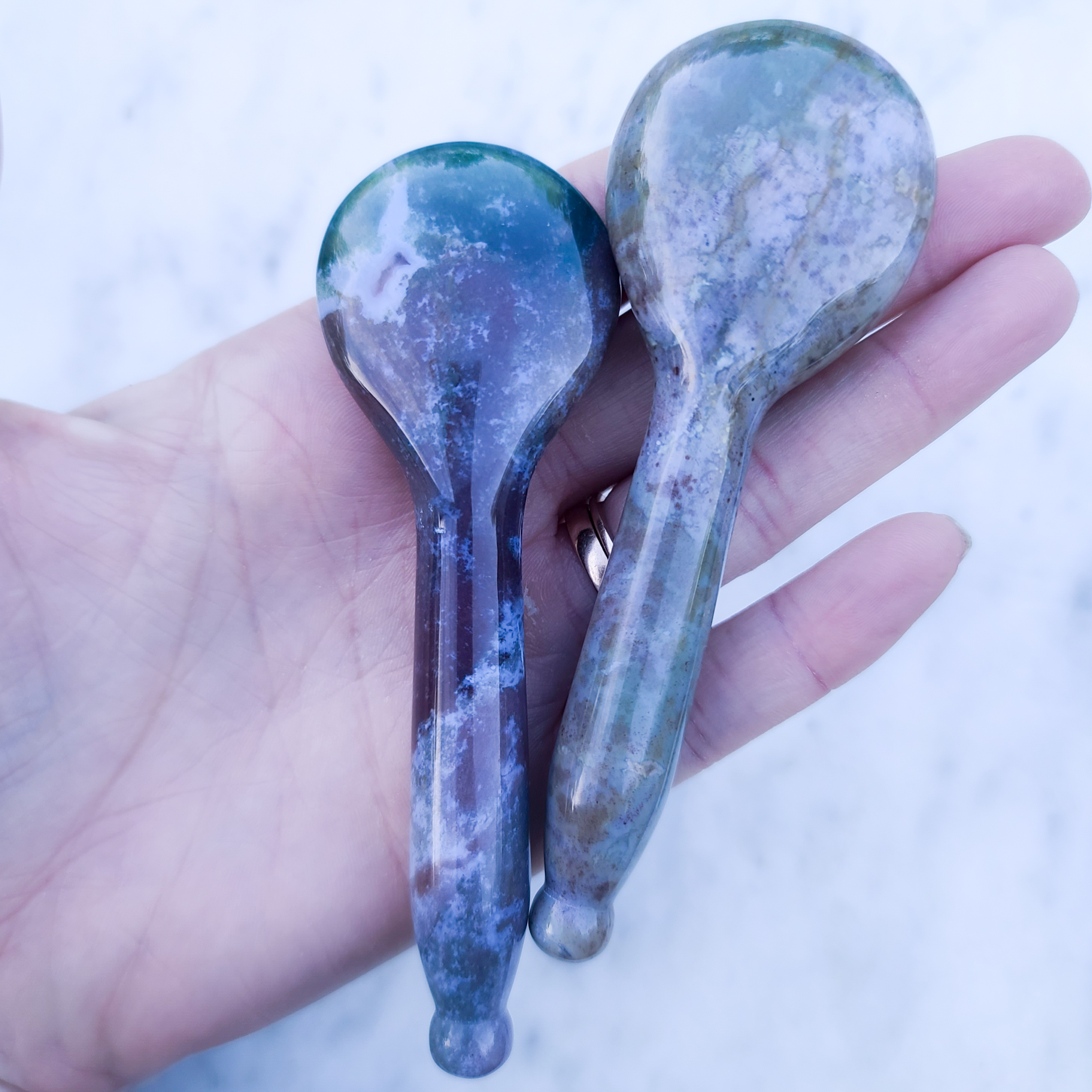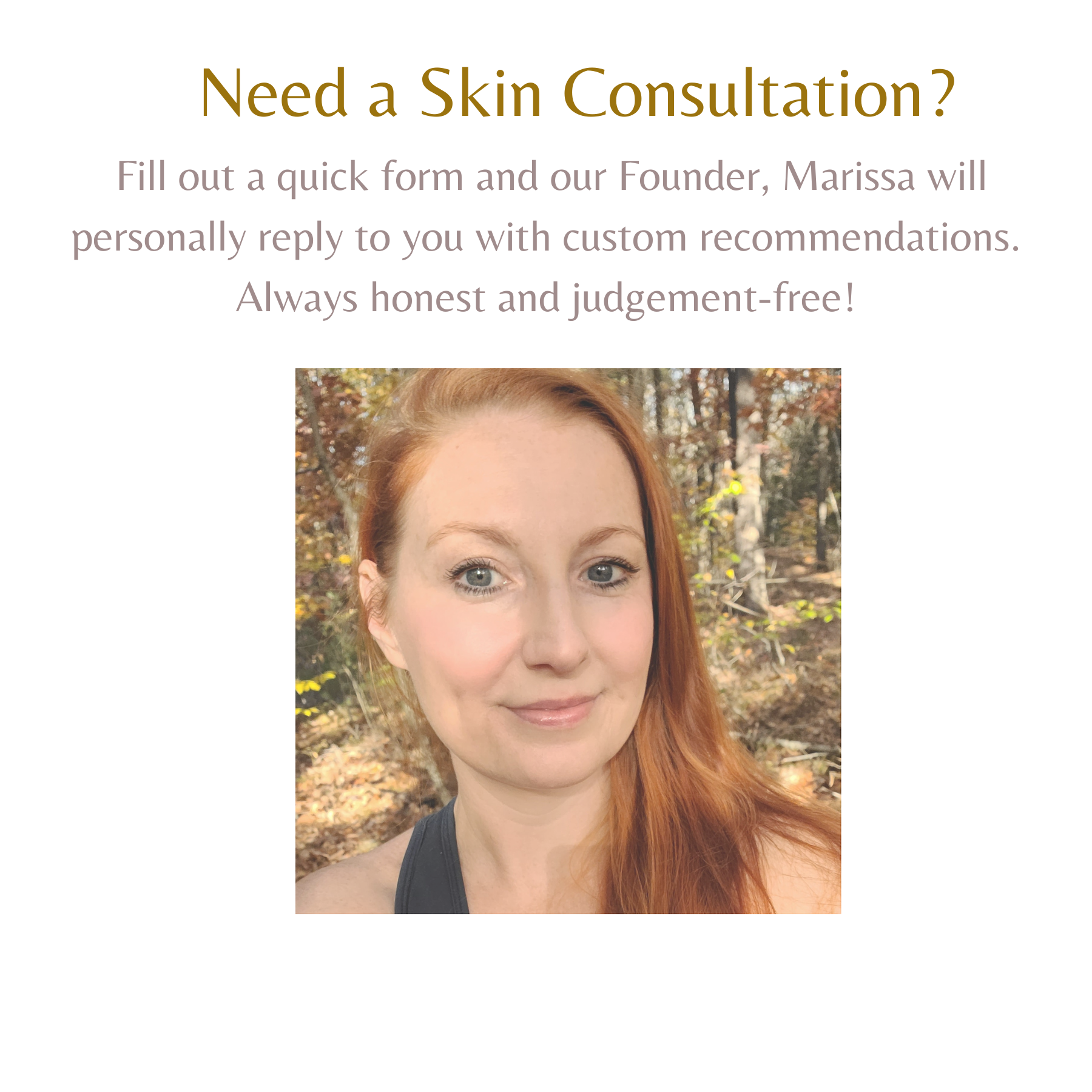Preface: We believe in supporting the health and wellbeing of ALL women, empowering them to introduce self-loving rituals which can increase confidence and sense of self. We believe gua sha is a beautiful modality, which combined with holistic lifestyle changes and plant-based products, can benefit the skin health all women. It is important to know and respect that Gua Sha is a traditional Chinese medicine, and learn from a thoughtful, highly skilled gua sha practitioner with formal training.
There's an ancient beauty treatment that’s made major waves lately in mainstream American beauty, called Gua Sha. Women are swearing by this technique for more lifted and contoured faces; some are even calling it the natural alternative to Injectables [1]. But it goes far beyond superficial beauty. You may have seen beauty enthusiasts rubbing jade or rose quartz stones on their faces and wondered what on earth they are doing. I’m going to give you all the juicy details about this highly beneficial beauty tool, benefits, proper technique, and where to learn.
↡ VIDEO TUTORIALS BELOW ↡
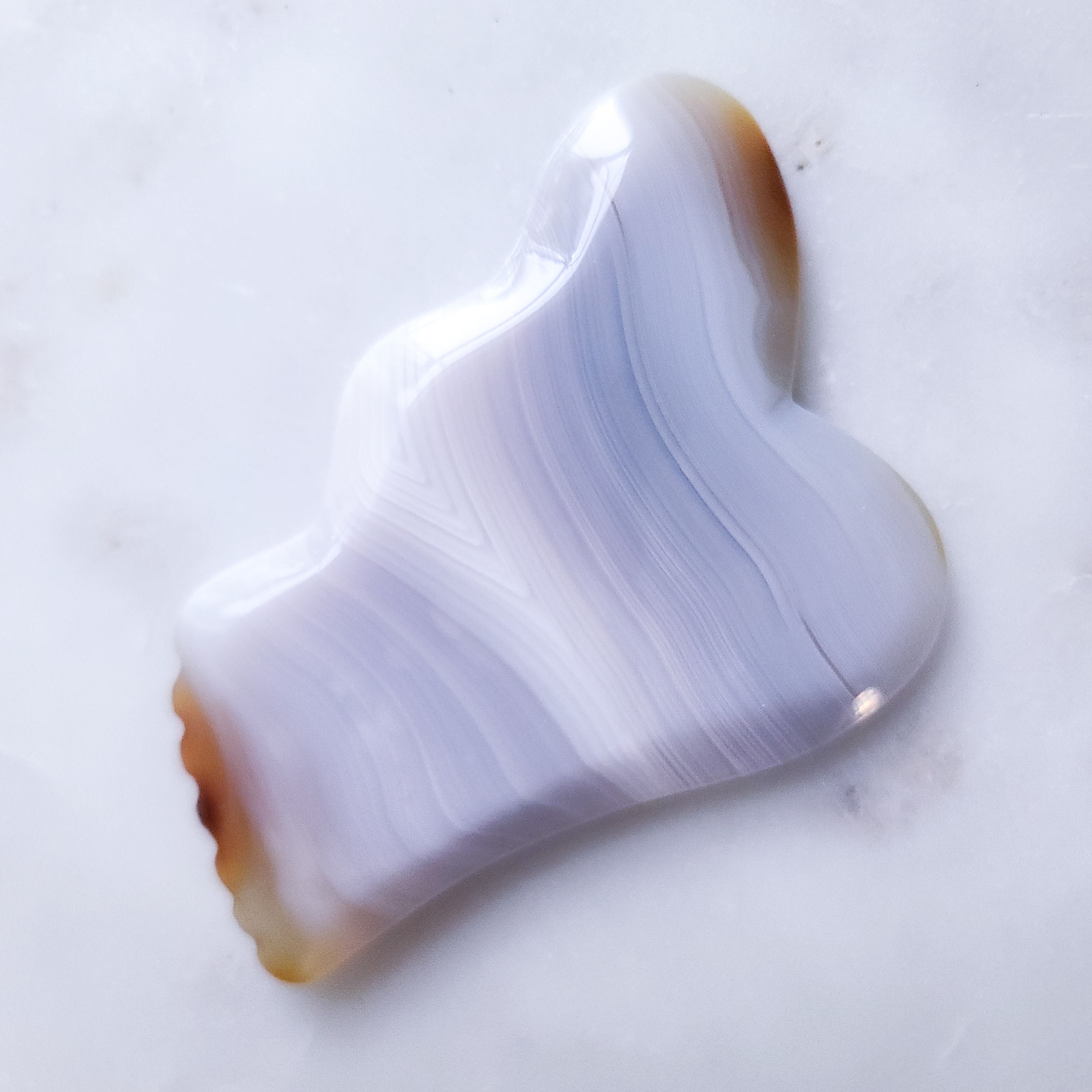
WHAT IS FACIAL GUA SHA
Gua Sha, is an ancient, traditional Chinese technique used to support the lymphatic system and relax muscles which can have a wealth of benefits, including clearer and visibly smoother skin. The traditional facial tool is a smooth, flat gemstone usually made from Jade, Bain stone, or Rose Quartz with curved or notched edges. Gua Sha can be used on the entire body, but we will be talking about the method of gentle Facial Gua Sha, including the neck. The Gua Sha tool is massaged or scraped along the skin in a sweeping outward/upward motion at various points on the face [1]. One of the main benefits of this technique is decreased appearance of puffiness, which is usually a result of lymphatic fluid not circulating freely throughout the body. Practicing Gua Sha on your face can release lymphatic fluid and the impurities it may contain, reducing a puffy appearance, eliminating toxins, promoting circulation, and activating the skin's natural ability to rejuvenate.[2][7] These benefits lead to clearer, nourished, glowing skin.
In a study conducted at the Unit of Circulation Research, University Hospital of Essen, Germany, it was concluded that: "Gua Sha increases microcirculation local to a treated area." The study indicates that microcirculation increased 400% in the first 7.5 minutes following gua sha treatment. And here's something interesting, females responded at a higher rate than males. [4]
But there's more! Gua Sha massage can also relieve tension in the muscles of the face, reducing the appearance of hardened facial expressions such as frown lines and lessening adhesions which interfere with proper fluid flow [3]. Adhesions are bound or fixed sections of tissue which are not normally united. In an article by Refinery 29, Brooklyn accupuncturist Sandra Lanshin Chiu says:“Think of a bunchy rug pad under a rug,” she explains... “If you smooth it out, the rug lays flatter and this helps circulation and the skin function more normally.” Gua Sha essentially re-patterns repetitive muscle movements, unwinding tissues and relaxing your face into it's natural state [1]. Logic would tell us that a relaxed face is a smooth face, right? Now, this next thought is for another article, but what about using that blank slate to practice some facial yoga? Release and Retrain is a genius plan if you ask me.
So now you might be asking yourself, what causes all that excess fluid and puffiness in my face? I'm all about solving the root of issues in a holistic manner, so it's important to understand the cause. The answer is typically inflammation [2]... or as I like to call it, The Root of All Evil. Inflammation is caused by numerous factors such as environmental pollution, toxic cosmetic ingredients, acidic foods, synthetic hormones, pesticides, alcohol, caffeine, smoking and more.
HISTORY OF GUA SHA
According to an article in chinaculture.org, Gua Sha treatments were "widely used by the Chinese" and "written into major medical records beginning in 1368 during the Ming dynasty." However, records of gua sha use go back to the Paleoithic period (old stone age), nearly 2.6 million years ago. During this time, stones were rubbed on individuals to alieviate illness. In theory, from the time man first constructed a stone tool, there was also gua sha. The evidence is unclear whether these first primitive humans originated from what we now call china, or if they had migrated from Africa.
Gua Sha is related to cupping and acupuncture in that they all work within the theory of Meridians in Traditional Chinese Medicine. "The meridians and collaterals are like the pathways in which the flow of qi and blood circulate. They form a specific network that communicates with the internal organs and limbs and connects the upper to the lower and the exterior to the interior organs of the body." says Yin Yin, author of the article in chinaculture.org [9].
By 2011, there were over 500 studies which establish how gua sha is used in China [10].
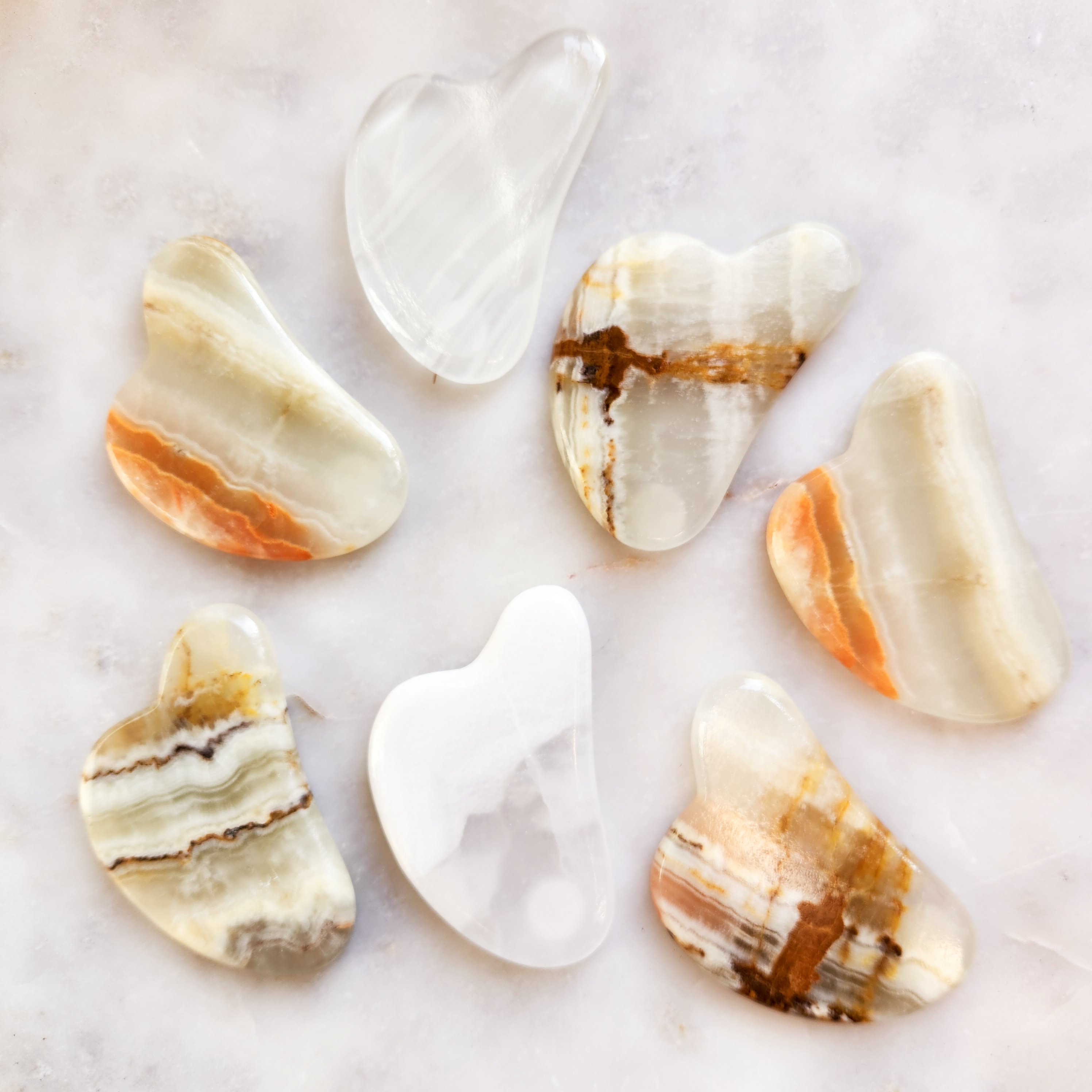
BENEFITS OF FACIAL GUA SHA
With the correct technique and consistent practice, Gua Sha can help to:
- Reduce visible Puffiness and dark circles, usually a result of excess and trapped fluids [2]
- Improve Circulation, bringing oxygen and nutrient-rich blood to skin cells [2] [4]
- Reduce Tension in facial muscles, softening the face and reducing the formation of harsh expression lines [3]
- Soften tissue adhesions which can inhibit the flow of vital fluids [3]
- Promote skin clarity, clearing acne and congestion, a result of improving the circulation of lymph and thereby eliminating toxins [2]
- Expedites the healing of pimples and other skin issues [7]
- Reduce visible signs of Inflammation caused by excess impurities in the lymph [2]
- Strengthens cells to improve collagen production [7]
- Improves skin radiance and brightens complexion [6] [7]
- Contour, and Sculpt the appearance of face for a more refined features [6]
- Visibly Lift and Tighten Skin [3] [7]
- Prepare the skin to better accept topical products for deeper and accelerated penetration [7]
- Relieve headaches and sinus congestion [3]
- Relax your body and nervous system to reduce stress anxiety, and even depression [5]
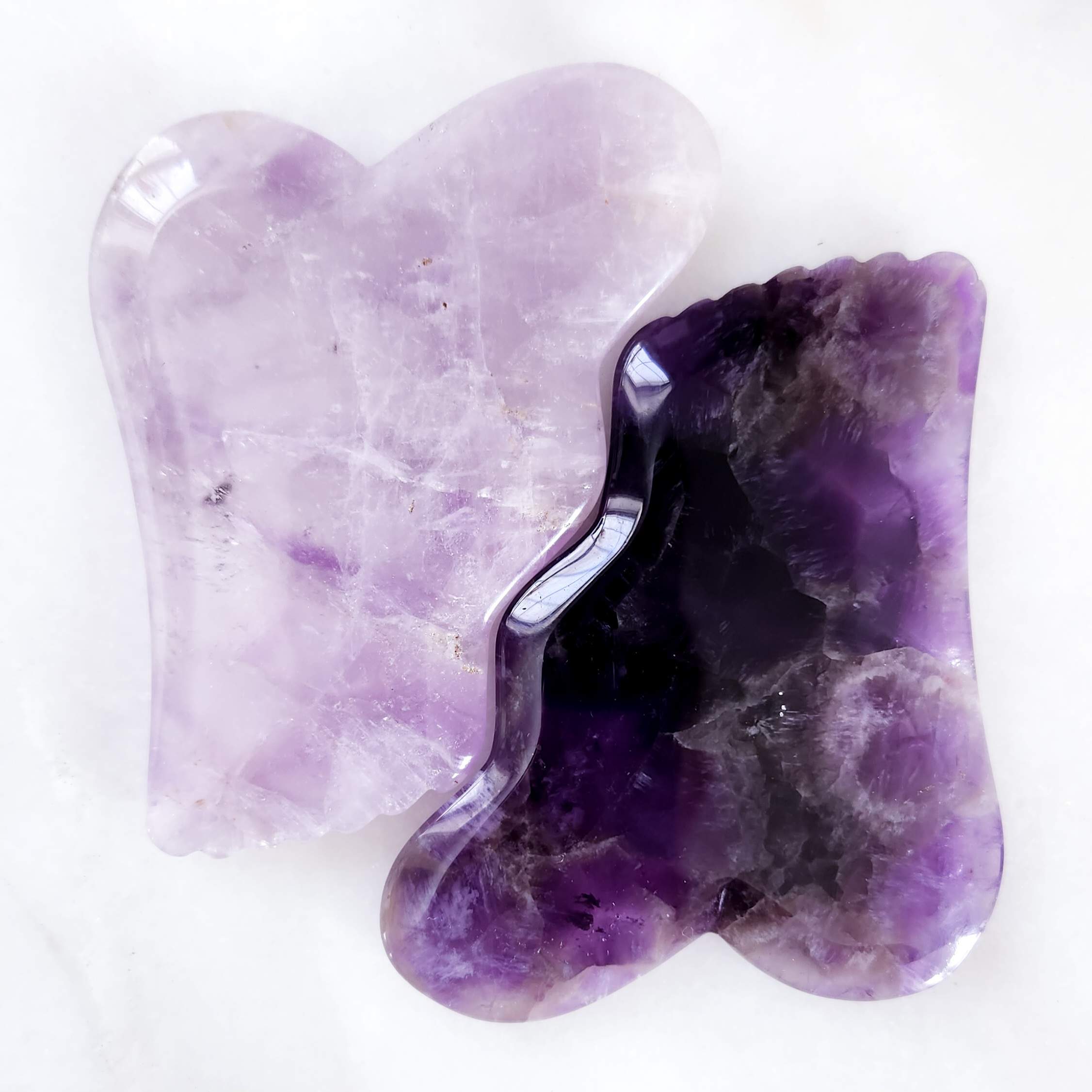
GUA SHA VS. GEMSTONE ROLLING
You may be asking yourself, why would I use Gua Sha over a Jade Roller?
Jade Rollers are a more convenient and user-friendly choice. Nearly anyone can quickly learn how to use a jade roller and easily go through a routine in a matter of minutes. Many love the way their face and skin look and feel with jade rolling. The benefits are real!
Gua Sha takes a bit more skill, care and time… however it’s believed that gua sha delves deeper, to really relieve heavy set tension, break up adhesions, and get things moving [3]. Because it is a slow and longer ritual, it also has a meditative and metaphysical aspect that many incorporate, which can really deepen your relaxation and connection with your body.
Ultimately, it’s a personal preference and many people love using both! Professional estheticians certainly make use of both tools, as I've observed.
HOW TO CHOOSE A GUA SHA TOOL
This choice will be personal but I suggest choosing the gemstone that speaks to you or which has metaphysical properties that you resonate with - I talk about those below. There are a myriad of shapes and sizes to choose from and you can't go wrong with even a simple shape. I am personally very drawn to my amethyst gua sha tool but love the extra heavy weight of my bain stone tool. Take your time to decide and you will treasure your selection.
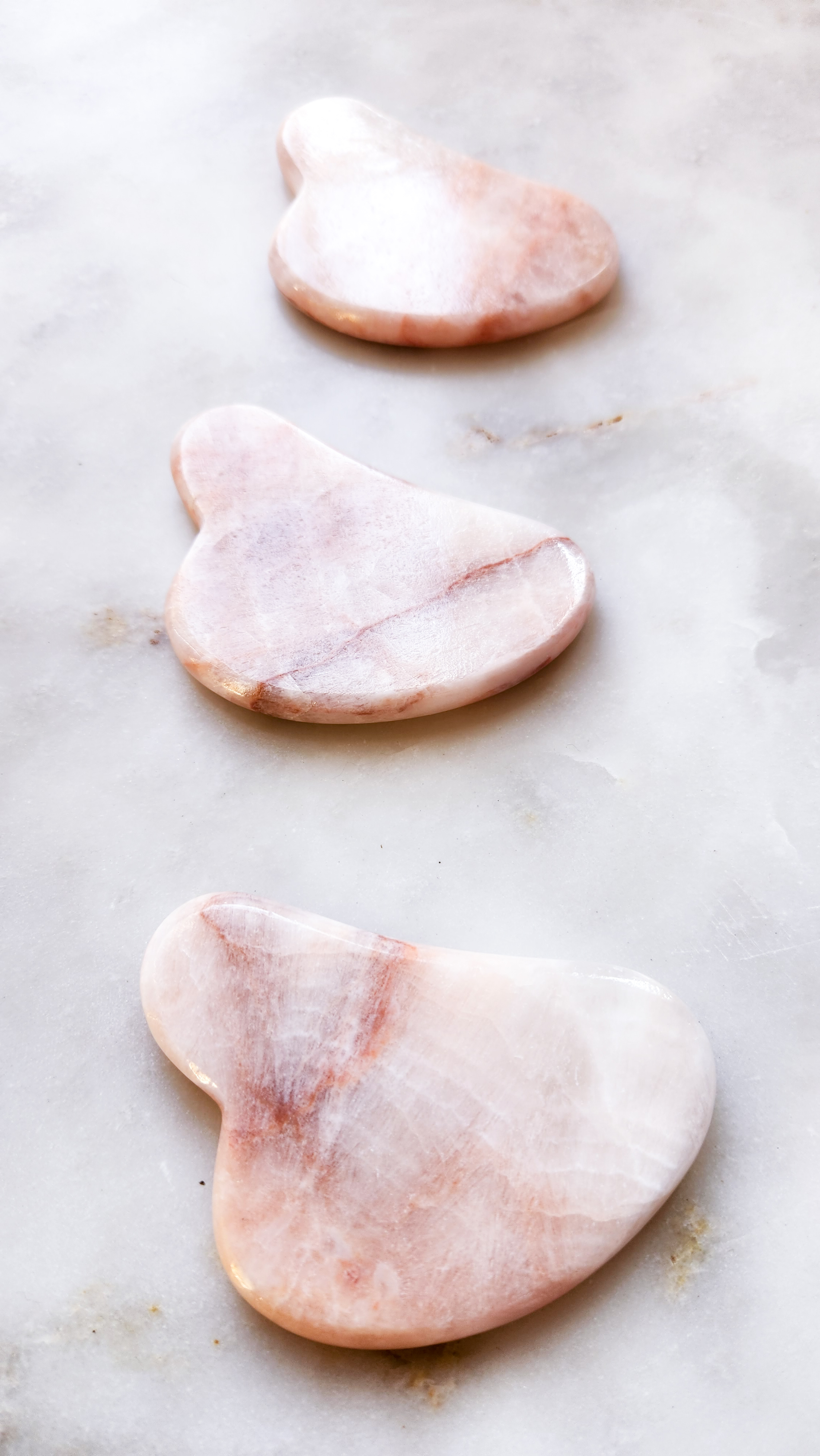
SHAPES AND USE OF VARIOUS GUA SHA TOOLS
All Gua Sha boards are made to hug the shape of the face, hence why most have several different edges to accommodate the different angles and curves of an individuals unique face. The shapes and edges below can often be found on all different gua sha tools and are not specific to only one style of tool. Below are suggested ways to utilize each edge you may find on your tool.
Comb Edge – Sweeping upward and outward motions on lines and wrinkles for tension, especially the extreme tension we carry in eyebrow and reduction of brow, frown or eleven lines.
Rounded Tip – Under Eye Area for feather-light de-puffing, reducing dark circles and lymphatic drainage.
Curved Edge – Perfect for the cheek bone area and upper brow.
Small Curved Edge or Flat Edge – Center forehead area to smooth lines and tension.
Camel Humps – Great for hitting the pressure points along and under the brow to take away tension and relieve sinus pressure.
Large Notch – Excellent for back of neck sweeping up to base of skull, front of neck up to chin, conturing the jaw line.
The 6 uses above can be seen in demonstration by Brooklyn Accupuncturist Sandra Lanshin Chiu by going to her Youtube channel here [6] or by Britta Plug by going to her Youtube Channel here [8]
HOW TO USE YOUR GUA SHA TOOL
We HIGHLY recommend learning how to perform Gua Sha on yourself, from a practitioner who has advanced proficiency in the modality of Gua Sha. We recommend learning from Holistic Esthetician Angela Golden. BOOK HERE.
Important tips before getting started:
There are various methods used by different practitioners, we have outlined some directions below, or you may follow along in our new Video Tutorial with The Organic Esthetician below!
DIRECTIONS
Prepare your skin:
Generously apply a hydration mist such as our Vital Botanic Hydrating Mist and gently press into your skin. Feel free to apply a second round if your skin is particularly thirsty.
Warm 5-10 drops of a serum or face oil between both palms, press into face, neck & decolette and massage in an upward/outward motion, giving extra love to areas of concern.
Continue in the order below, sweeping 5-10 times for each section. Remember, light and gentle pressure!
Back of Neck – Notched Edge
Using one of the notched edges, place the gua sha tool at the base of your neck, holding as flat as possible against your skin. Pull the tool upward with light to medium pressure until the tool hits bone at the back of your skull. Give yourself a massage in that location by wiggling the tool.
Shoulder/Side of Neck – Flat Surface and Curved Edge
Using the Flat or gradually curved edge of your tool, place the surface of your tool at the end of your shoulder, just before the collar bone meets the shoulder. Keeping the tool flat, pull the tool up your shoulder and side of your neck with light to medium pressure until it touches bone just under your ear. Give the tool a little wiggle to massage that spot.
Collarbone/Front of Neck – Flat Surface and Curved Edge
Using the Flat or slightly curved edge of your tool, place the surface of your tool just under your collar bone. Pull the tool upward over your collar bone and up your neck until it touches bone just under your jaw. Give the tool a little wiggle to massage that spot.
Sternum/Front of Neck – Notched Edge
Place your fingers at the top of your sternum, just between where your collar bones meet. This provides support to the skin. Place the notched edge of the tool just above your fingers. Keeping the tool as flat to your skin as possible, pull the tool upward until it hits bone, just under your chin. Give yourself a massage in that location by wiggling the tool. Repeat 5 times more more.
Jaw Release Lift & Sculpt – Notched Edge
Place your fingers at the center of your chin, place the notched edge of the tool next to your fingers so that there is a tip on both the top and bottom of your jar. Keeping the tool as flat as possible, pull the tool outward following the line of your jaw until it touches just under the ear. Give yourself a massage in that location by wiggling the tool.
Cheek Sculpt & Lift - Flat Surface and Smooth Edge
Place your fingers over your nose and on your cheek just next to your nose to support the skin. Place smooth edge of the tool next to your fingers, keeping the tool as flat to your skin as possible. Pull the tool outward until you reach your ear.Give yourself a massage in that location by wiggling the tool.
Under Eye Refresh – Rounded Tip
This is an area of very thin and fragile skin, please use feather-light pressure when treating the eye area. Place a finger just below the inner corner of your eye. Lightly place the curved tip of the tool flat next to your finger under your eye. Gently and lightly pull the tool to the outer corner of the eye and then outward/upward to the temple. When you reach the hairline, wiggle the tool in a massage type motion.
Brow Lift & Eye Opener – Notched Edge
Place a finger or two between your brow to support the skin. Place the notched part of the tool next to your fingers and lay the tool flat to the skin. Pull the tool outward, following the brow bone. When you reach the end of your brow bone, turn the tool upward and pull it upward/outward until you reach your hairline. When you reach the hairline, give yourself a massage in that location by wiggling the tool.
Forehead Smoothing & Brow Lift – Curved Edge
Place your finger under the center of your brow bone, feather light touch to support the skin. Using the long curved edge of your tool, touch your finger at a flat angle and pull the tool upward over your brow bone and continue up forehead. When you reach the hairline, give the tool a little wiggle to massage that spot.
Center Forehead – Shorter Flat Edge
Place your fingers gently between your brows to support the skin. Place the shorter flat edge of the tool just above your fingers and pull the tool upward until you reach the hairline.When you reach the hairline, give yourself a massage in that location by wiggling the tool.
You’ve now completed one full side of your face and can repeat these movements on the opposite side. Do you notice a difference in your appearance? Does the treated side of your face look lifted and brightened?
We suggest practicing Facial Gua Sha daily or as often as you like. Consistency will be the trick to gaining desired results. Truly take your time and enjoy this relaxing and rejuvenating ritual.
The 10 skills above were learned, practiced and interpreted from a variety of expert video tutorials and guides as follows: [6] [7] [8] and [1]
Wilder North cannot be held responsible for any actions made, implied or expressed by anyone as a result of this guidance.
The above statements are for educational purposes only and have not been evaluated by the FDA. They are in no way intended to heal, prevent or treat any illness. Please consult your doctor if you are seeking medical advice.
I would like to thank Experts Britta Plug and Sandra Lanshin Chiu for continually providing complimentary Gua Sha education to the public via their expert video tutorials, blogs, instagram shares and more.
The above content is the result of my own knowledge and research done using knowledge from the following resources, to whom we have no association:
[1] https://www.harpersbazaar.com/beauty/skin-care/a27229712/gua-sha-benefits-botox-alternative/ Harpers Bazaar online publication, Author Prue Lewington 05/23/19
[2] https://www.mindbodygreen.com/0-26477/this-jade-crystal-massage-will-depuff-your-whole-face.html Mind Body Green online publication, Author Britta Plug
[3] https://www.refinery29.com/en-us/gua-sha-facial-chinese-treatment-review Refinery 29 onine publication, Author Katie Becker, courtesy Sandra Lanshin Chiu 02/01/17
[4] https://www.ncbi.nlm.nih.gov/pubmed/17905355 Study conducted at Department of Nephrology, Unit of Circulation Research, University Hospital of Essen, Germany. Nielsen A, Knoblauch NTM, Dobos GJ, Michalsen A, Kaptchuk TJ. The effect of Gua Sha treatment on the microcirculation of surface tissue: a pilot study in healthy subjects. Explore (NY). 2007;3(5) (October):456-466.
[5] https://www.ncbi.nlm.nih.gov/pmc/articles/PMC4433678/ Published research paper conducted by Xingze Wang 06/10/15
[6] https://www.lanshin.com/ AND https://www.youtube.com/watch?v=Bc12OTFzua0 - Sandra Lanshin Chiu, LAC, Treatments by Lanshin Founder, Accupuncturist & Herbalist
[7] https://thechalkboardmag.com/how-to-use-gua-sha-facial - 10/17/18 The Chalkboard online publication, author unknown
[8] https://www.youtube.com/watch?v=krjC-BWB0XY - Video Gua Sha demonstration by Esthetician Britta Plug
[9] http://en.chinaculture.org/info/2013-04/25/content_456628_2.htm - online publication, author Yin Yin
[10] https://www.pacificcollege.edu/news/press-releases/2015/05/05/science-gua-sha - online publication from The Pacific College or Oriental Medicine, author Arya Nielsen, PhD
